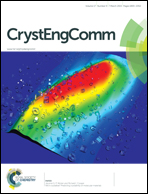An in situ EDXRD kinetic and mechanistic study of the hydrothermal crystallization of TiO2 nanoparticles from nitric acid peptized sol–gel
Abstract
In situ energy dispersive X-ray diffraction (EDXRD) has been used to monitor the crystallization of TiO2 nanoparticles from hydrothermal reactions of nitric acid (HNO3) peptized sol–gels at 210, 230, 250 and 270 °C. The EDXRD peaks revealed the formation of pure rutile phase TiO2 particles from all the hydrothermal reactions studied. The reaction kinetic data have been determined by monitoring changes in the integrated peak areas of the highest intensity diffraction peak (110). A kinetic and mechanistic analysis of the hydrothermal synthesis of TiO2 nanoparticles has been proposed based on the Avrami–Erofe'ev kinetic model. The Avrami exponent values obtained were within the range of around 0.5–1 for all the reactions studied, indicating that the hydrothermal crystallization of TiO2 nanoparticles involves a diffusion-controlled process mechanism. The as-synthesized TiO2 nanoparticles have been further characterized by powder X-ray diffraction (XRD) and transmission electron microscopy (TEM). The XRD data are in good agreement with the EDXRD results and confirm the formation of pure rutile phase TiO2 particles. The TEM results showed that the TiO2 particles produced are below 100 nm in size and exhibit bi-modal size and morphology distribution.


 Please wait while we load your content...
Please wait while we load your content...